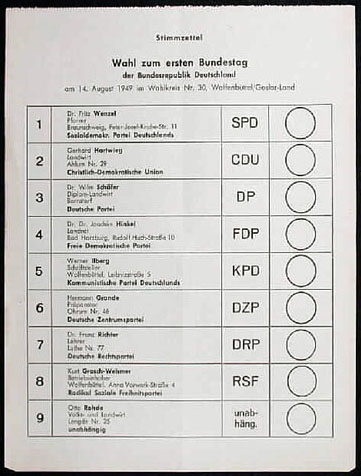Election of the first German Bundestag
- 14. August 2019 - General, Germany, Historical Events, History, Knowledge
Free elections are considered something normal in Germany. Every four years the public votes for our parliament – the Bundestag. Today, 70 years ago the first federal elections were held.
On 14 August 1949, the first free federal elections were held after the last ones happened on 06 November 1932. Before that, the public could only elect the regional and local parliaments where elections were already held in 1946. The first federal elections were only conducted on the territory of the Federal Republic of Germany (FRG), not on the territory of the German Democratic Republic (GDR), which was founded on 07 October 1949.
The basis for the first federal election were the Grundgesetz (constitution), which was passed on 23 May 1949, and the election law, which was specifically made for this election by minister presidents and the parliamentary council. Some corrections of the election law were made by the occupying powers.
From today's perspective, the first federal elections in the FRG were kind of strange, because many rules that apply now, were not binding then. For example, the so-called "five-percent-hurdle" which basically means that a party has to reach at least 5% in an election to be part of a parliament, did only exist on regional levels. If a party reached 5% in one of the many regions or won a voting district, it automatically became part of the Bundestag. As a result, there were eleven parties in the first freely elected parliament in Germany after the Second World War. In today's legislative period, there are six parties in the Bundestag. However, the number of eligible parties was restricted due to the fact that every party had to obtain a license from the allies to be part of an election. This rule was active until 17 March 1950.
Furthermore, every voter only had one vote with which he could vote for one party. Today, everyone gets two votes. One is given to a specific district official whilst the other is given to a party. This means one gets the chance to vote for two different parties. The two votes are amongst other things supposed to make sure that every region is represented in the parliament. This was not the case during the first federal elections. Only for the second elections in 1953 the five-percent-hurdle as well as the first and second vote were established. The electoral system was a compromise of the different parliamentary groups that were in favor of different electoral system.
The first federal election was special for another reason. As already mentioned, on 23 May 1949, the Grundgesetz was approved. However, this happened without the consent of the general public, because there were only regional- und local elections at the time. But the high turnout of the first election, around 78.5%, was considered as acceptance of the law by the general public.
On 07 September 1949 a new government was formed by a coalition of the CDU, the FDP and then still existing DP. One week later, on 14 September 14 1949, the first German president Theodor Heuss was elected. And one day later, on 15 September 1949, Konrad Adenauer became the first German chancellor. After the Second World War, the system of president and chancellor was introduced in Germany in order to prevent that a president that is directly elected by the public can become too powerful. In fact, today the voters neither elect the president nor the chancellor directly. They only decide on the composition of the parliament. The president is elected by a federal assembly which consists of members of parliament as well as representatives of the federal states. The chancellor is the actual head of the government. He is elected by the Bundestag, after the president suggested a candidate. However, big parties usually already have a fixed candidate to give the voter a good idea on who might be their next chancellor.
In the first German Bundestag there were 410 members of parliament, of whom 402 had full voting rights. The other eight members came from Berlin and only had a restricted voting right due to the fact that Berlin was still under the four-power-status which meant every law had to be passed separately in Berlin.
Although the Second World War was just over and the NS-dictatorship was defeated, there were still some rather right-wing parties in the first Bundestag. One of them was the coalition partner of the CDU and FDP, called DP or German Party. While this was a party that already existed in Weimar Republic and was banned by National Socialists they at least were hoping for votes from former sympathizers. According to the social scientists Manfred Rowold and Stefan Immerfall said that the DP mainly focused on middle-class voters who positioned themselves on the conservative edge on the brink to right-wing extremism. On the left wing, the KPD, the German Communist Party, also was part of the first free German parliament until it was banned in 1953. In general, there were many parties in the first Bundestag that today’s voters would not know. Either because they do not exist anymore or because they lost significance over the last decades.


0 comments